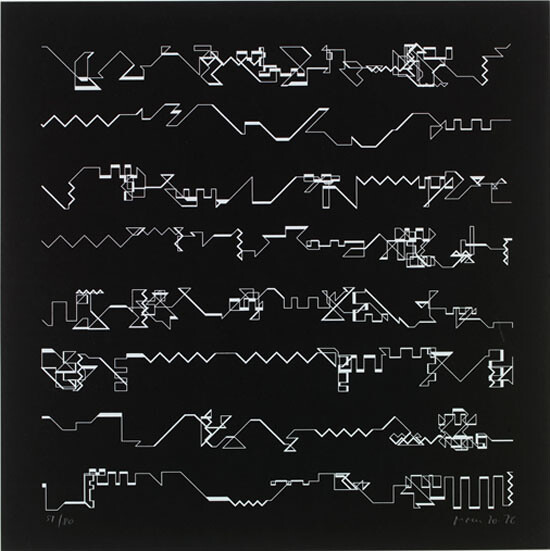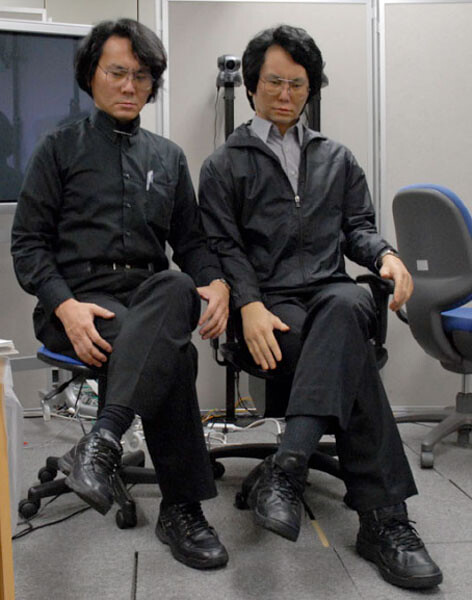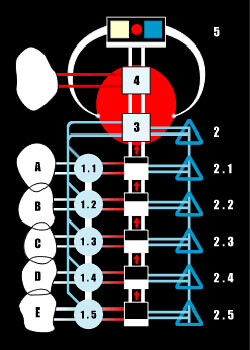In the early years of the twenty-first century there emerged a renewed interest in theoretical ideas of acceleration. The key figure in these discussions has been the British philosopher Nick Land. The term “accelerationism,” itself coined by Benjamin Noys (in a characteristically critical register), bares some explanation. As Noys defines it, accelerationism describes certain libertarian post-Marxist positions (Deleuze and Guattari’s Anti-Oedipus, Lyotard’s Libidinal Economy, and the Baudrillard of the mid-1970s). According to Noys,
[Such thinkers] reply to Marx’s contention that “the real barrier of capitalist production is capital itself,” by arguing that we must crash through this barrier by turning capitalism against itself. They are an exotic variant of la politique du pire: if capitalism generates its own forces of dissolution then the necessity is to radicalise capitalism itself: the worse the better. We can call this tendency accelerationism.1
It is Land who exemplified, and indeed exacerbated, this strategy of “the worse the better” to new heights of sick perversity in the 1990s. But what is of interest to us is not so much questions of conceptual genealogy but the resurgence of the idea: What is accelerationism today?
At present we find a swarm of new ideas operating under this rubric, ranging from post-capitalist techno-political theory, to sci-fi speculative cosmist design, to universal rationalist epistemologies. It is to be suggested that this return to ideas of acceleration must be indexed to our present condition of political, economic, and cultural decay. And though Land’s own ideas of what is to be accelerated, and in what acceleration consists, have been superseded, such references, now existing at multiple levels (epistemic, ontological, political, cosmological) might now come to be marshaled more directly against the spectre of a greying, obese, and yet still hegemonically rictus-tight neoliberal order.
In this, the role of the aesthetic must similarly shift. For whereas in Land’s schema of acceleration the aesthetic is both omnipresent and yet denied autonomy, in this newly imagined envisioning of the idea, the aesthetic may come to take on a more independent and causally significant role.


The Heresies of Nick Land
Nick Land was amongst the most prescient thinkers of the capitalism emerging in the mid-1990s. His work combined the cybernetics of Norbert Weiner with emerging Deleuzo-Guattarian libidinal philosophy, complexity science, UK rave culture, and cyberpunk pulp fiction, to generate a kind of pitch-black psychedelic reductio ad absurdum of neoliberal ideology. Key to Land’s thinking was an idea he drew from Deleuze and Guattari’s Capitalism and Schizophrenia project: capitalism differs from prior social formations in that it operates through processes of deterritorialization, which work to liberate inhibited dynamics of creativity, previously carefully imprisoned in primitive or despotic taboos. Land hijacked this schematization, bringing out an implicit inhuman pro-capitalism. Deleuze and Guattari asked:
Which is the revolutionary path? … To withdraw from the world market? … Or might it be to go in the opposite direction? To go still further, that is, in the movement of the market? … Not to withdraw from the process, but to go further, to “accelerate the process.”2
To this question, Land answered in the affirmative. Where Deleuze and Guattari ultimately counseled caution, to accelerate with care to avoid total destruction, Land favored an absolute process of acceleration and deterritorialization, identifying capitalism as the ultimate agent of history. As Land puts it, “Capitalism has no external limit, it has consumed life and biological intelligence, [and it is] vast beyond human anticipation.”3 Here, the deregulation, privatization, and commodification of neoliberal capitalism will serve to destroy all stratification within society, generating in the process unheard of novelties. Politics and all morality, particularly of the leftist variety, are a blockage to this fundamental historical process. Land had a hypnotizing belief that capitalist speed alone could generate a global transition towards unparalleled technological singularity. In this visioning of capital, even the human itself can eventually be discarded as mere drag to an abstract planetary intelligence rapidly constructing itself from the bricolaged fragments of former civilizations. As Land has it, through the acceleration of global capitalism the human will be dissolved in a technological apotheosis, effectively experiencing a species-wide suicide as the ultimate stimulant head rush.
As bizarre as it may sound to the ears of the present day, this brand of thinking made a twisted kind of sense in the 1990s. This was the decade after the collapse of actually existing Communism, when capitalism stood entirely unopposed, when Francis Fukuyama was declaring “The End of History.” With the expansion of digital culture and the widespread adoption of internet technologies, techno-utopians such as Kevin Kelly were pronouncing the advent of a new social and economic epoch. And while much of culture was already mired in retrograde maneuverings, underground dance music fully embodied the inhuman science-fictional vision of Land, suffused with alien sonic innovations, contorted into an apocalyptic paranoid euphoria. As Land himself put it, this was “impending human extinction becoming accessible as a dance-floor,” a prime way (along with the production of theory and the ingestion of accelerant narcotics) that the unrepresentable speed of inhuman capitalism could be experienced by individual humans. This was an alienation that was enjoyable, to be perversely desired.


Acceleration > Speed
But if Land’s rabidly nihilistic vision of global capitalist acceleration made sense in the fervid 1990s, it makes less sense today. One reason for this is that Land’s accelerationist schema rejects politics as a sentimental excrescence, as a matter simply of buttressing the incontinent egos of wet liberals and feeble Marxists. On Land’s account, at least, the raw accelerative force of capitalistic innovation alone ought to be sufficient to drive revolutionary change. But as Deleuze and Guattari recognized, what capitalist speed deterritorializes with one hand, it reterritorializes with the other. Social modernization becomes caked in the kitsch remainders of our communal past, as Thatcherite-Reaganite deregulation sits comfortably beside pseudo-Victorian family and religious values. A deep tension exists within neoliberal capitalism, between its self-image as the singular vehicle of modernity, and the somewhat paltry reality it is in fact capable of providing. Far from dissolving the social in the universal acid of hyper-technological acceleration, today the best we can hope for is marginally improved consumer gadgetry, against a background of political inertia, cultural hyperstasis, ecological collapse, and a growing resource crisis. Technological progress, rather than erasing the personal, has become almost entirely Oedipalized, ever more focused on supporting the liberal individual subject. The very agent which Land identified as the engine of untold innovation has run dry. This is alienation of an all-too familiar, ennui-inducing kind, rather than a coldly thrilling succession of future-shocks. All of this opens up a space for the political again: if we desire a radically innovative social formation, capital alone will not deliver.
Moreover, from a philosophical perspective, Landian accelerationism flattens real distinctions in the world into a crudely univocal system. The key consequences of this is an inability to demarcate the differences between thinking and being, reducing the rational to the ontological. In this regard, Land follows Deleuze and numerous other process philosophers. As Ray Brassier has argued, this leads to a scenario where, since difference is what ultimately undergirds the reality of being, and thought is merely a difference in being, everything which is, to some extent, thinks. In this fashion, a pre-critical panpsychism emerges, unable to properly account for the status of logical or normative rational thought.4 With Land, this problematic antirationalism finally results in an elision not just of thinking and being, but of the ontological and the aesthetic.5 Even theory itself becomes a mere stimulant, outside of any reference to external truth, capable only of inculcating an affective state that enables limited access for individual subjects to the ultra-complex becoming of capital-as-world-devouring-intelligence-system. This process leaves Land’s theory unmoored and incapable of justifying itself, except perhaps via a Nietzschean investment in the “force” of literary style, the libidinal pull of text itself.6
At the level of the mechanics of acceleration, Reza Negarestani has prosecuted the critique that the Landian position, grounded in a conception of machinic efficacy, is constitutively unable to generate the kind of apocalyptic teleological dynamics he envisions.7 Land’s singularitarian future depends upon an underlying system of capitalistic self-augmentation, ultimately resting on an algorithmic paradigm of recursive computation. Following the critique of the philosopher of science Giuseppe Longo, all computational systems function according to an operative architecture which is discrete, built from individual instructions, akin to the stages of a recipe, and this discrete, finitized conception of time is distinctly inadequate to match the continuous processes we find in nature.8 As well as discrete processes, computational systems also exhibit a crude quantization in terms of measurement. When computers are used to model complex natural systems (for example, human neurology or weather systems) subtle differences in starting conditions get simplified, occluded in a “blocky” or “pixelated” rounding off. In complex systems, nonlinear feedback processes lead even infinitesimally small differences in initial conditions to generate vastly divergent results over time. The continuous nature of reality escapes the quantized grasp of our present computational paradigm, and that paradigm rests at the core of Land’s machinery of acceleration: a unidirectional accumulative process of algorithmic amplification.
One final line of problematization for the Landian program of accelerationism concerns its presumptions relating to the meaning of freedom. In common with much liberal and neoliberal thought, Land conceives of a primary freedom which various forms of structure inhibit. Though distinguished by his rigorous inhumanism (vis-à-vis, say, a classical liberal like Locke) he maintains an interest in a merely negative freedom: the freedom of capital from deleterious (and misguided) human intervention. This is, however, to entirely ignore the richer and more suggestive domain of positive freedom. It is in this sense that Land confuses speed with acceleration. We may be moving fast today, but only within a strictly defined set of capitalist parameters that themselves never waver. As such, Landian accelerationism is stuck in a merely dromological register, a localized ramping up of intensity, rather than a more properly accelerative regime capable of navigating beyond the ultimately mind-numbing capitalist axiomatic of accumulation-for-accumulation’s sake.9 These critiques of the Landian position collectively constitute the basis for a reformatted, updated, and thoroughly upgraded notion of what accelerationism might mean.


For A New Enlightenment
To begin with the last and most significant of these criticisms, what must bind together otherwise divergent new accelerationist approaches is an overriding project of freedom.10 In this respect, accelerationism today has moved closer to a classically Kantian perspective: freedom consisting in the following of (rational-normative) rules, so as to free ourselves from the impulsions of drive. This is what Brassier describes as a “cultural achievement,” the erection of an artificial order of rational, rule-governed imperatives enabling an evasion of ever more modulated and manipulated impulses. In contradistinction to libertarian and purely negative conceptions of freedom, the tyranny of drive, impulse, emotion, and affectivity can be supplanted only to the extent that such libidinal phenomena are held in check by the formalized workings of reason, a non-natural, synthetic edifice, a positive construction developed in the face of a universe which would otherwise leave us the slaves of baser instinct. What distinguishes this position from a mere regurgitation of familiar Enlightenment tropes is a maximal yet rigorously inhuman Prometheanism. It is this inhumanized Promethean account of freedom which threads together the disparate fabrics of epistemic, political, and cosmist accelerationism. As epistemic accelerationism engenders new modes of thinking and new bodies of knowledge, so political accelerationism generates new social and economic systems to embody, express, and capitalize upon these rationalist gains. Our epistemic and causal capacities are expanded in tandem, in the fashion of a ratchet.
The twin thinkers of epistemic accelerationism are Ray Brassier and Reza Negarestani. Accelerationism in this guise is the project of maximizing rational capacity—the contents of knowledge about the world—and enabling the ramification of the conceptual space of reason. For both Brassier and Negarestani, this process is one which proceeds via alienation. For Brassier, this is due to a direct identification of the processes of scientific discovery with nihilism. Enlightenment, rather than entailing an edifying reassurance of the humanistic order, instead gradually but irreparably modifies the manifest image of ourselves-in-the-world, stripping back the comforting homilies of humanism to reveal, Terminator-style, the gleaming bones of Wilfrid Sellars’s empty, formalist, rational subject lying beneath.
For Negarestani, epistemic acceleration rests in generating new ways to navigate conceptually. This spatialized, geometric understanding of conceptual behavior emphasizes the creative aspects of thought, focusing on conceptual discovery and abductive transition, over and above analytic parsimony. This modern system of knowledge, much inspired by recent work in the synthetic philosophy of mathematics,11 is driven by opportunities to build connections, bootstrapping out of local horizons of knowledge and tracing the pathways which exist towards more globalized conceptual horizons. In this sense, Negarestani’s project is one which argues for a “true to the universe” thought, which binds the traumatic and vertiginous inhuman perspectives that scientific and mathematical thought provide to the rational subject.12 This revolution “for and by the open”13 prioritizes neither the global over the local nor the local over the global, but rather their imbrication with one another, their potential for perforation, and their possibilities for transplantation or transition. Considered from the perspective of an epistemological account of conceptual space, this is to operate under the rational injunction towards exploration, albeit of a necessarily traumatic kind. Epistemic acceleration then consists in the expansion and exploration of conceptual capacity, fed by new techno-scientific knowledges, resulting in the continual turning-inside-out of the humanist subject in a perpetual Copernican revolution. In so doing, epistemic accelerationisms preserve the crucial distinctions between thought and being, and hence are capable of undergirding a rationalist picture of the world and its operations.
As Nick Srnicek has argued, one significant pinion point between epistemic and political acceleration is the potential for the transformation of economics. Here, epistemological gains directly interface with technological, social, and political ones. Srnicek reasons that economic models effectively operate as navigational systems for particular social and ideological infrastructures, and as such we can distinguish between those models which provide orientation and strategic support for the current capitalist system, and those which might provide resources by which we could navigate towards a future post-capitalist society. In this fashion, “the critique of restricted knowledge therefore parallels the critique of restricted economies.”14 In other words, new ways of thinking about the economy can have dramatic effects on how actual economies operate. The post-capitalist order which political accelerationism takes as its immediate goal necessarily depends on the ability to transform the discipline of economics and the body of knowledge it supports and instantiates. The transformation of economics can be seen as one important element within a broader process of transition, with the development of new models and cognitive maps of the existing system leading towards the development of a speculative image of the future economic system.
Beyond the economic, political accelerationism seeks to revolutionize the contemporary political Left. Holding that capitalism now constrains the productive forces of technology, directing them towards narrow and often fruitless ends, accelerationism as a political project proposes identifying latent productive forces which must be unleashed against neoliberalism. Rather than working to smash the current capitalist system, the existing infrastructure is here identified as a platform requiring repurposing towards post-capitalist, collective ends. Technology, from this standpoint, is enslaved to myopic capitalist purposes, with the wager being that the real transformative potentials of much scientific and technical research remain untapped. These pre-adaptations may become decisive, but only sociopolitical action is capable of activating them, meaning that technological change alone will remain entirely insufficient to radically alter our world. What ought to be aimed towards, this tendency suggests, is a sociotechnical hegemony, with the goal of repurposing the present material platforms of finance, production, logistics, and consumption towards post-capitalist ends. What accelerationist politics proposes is that only a future that is more modern—an alternative future that neoliberalism is inherently unable to generate—will be sufficient to motivate a genuinely transformative and coherent politics.15


Such a future is only going to be possible with significant transformations in the radical Left. The Euro-American Left’s current obsessions with localism, direct action, and deliberative democracy are ill-matched when confronted with the acephalous monstrosity that is global capital today. What is therefore necessary is the constitution of a Left comfortable with globality, complexity, mediation, quantification, and technology, rather than sentimentalized modes of action and organization more suited to generating an affective sensation of feeling good in pious defeat, rather than efficacious action. The fetishization of localized horizons of direct democracy must be replaced by a more substantive conception of collective self-mastery, wherein the more we are able to harness our knowledge of the social and technical world, the better we will be able to effectively rule ourselves. This Promethean politics of maximal mastery over society and its environment will necessarily be highly experimental in nature. The older forms of mastery more traditionally associated with Enlightenment thinking stressed a Laplacian absolute knowledge, fit for a clockwork Newtonian universe. Today, our knowledge of non-trivial complex systems means that any attempts at mastering our world entail developing a mode of action which is more capable of metabolizing contingency, able to use the technical tools at its disposal to model the range of possible outcomes to any interventions.16
Finally, it is only a post-capitalist sociopolitical model which is likely to be capable of launching a robust cosmist imperative. The first two thirds of the twentieth century saw astounding leaps forward in technology and political and social consciousness, with the era immediately after the Second World War (running up to about 1979) the apogee of future-oriented thought in scientific and popular culture. But these futurological visions of the revolutionary intersection of techno-scientific development and social transformation, after the advent of neoliberalism, were quickly replaced by a yearning for kitsch retro-futurism. This is the story of modernism and early postmodernism collapsing into what might be termed a generalized chronosickness: a loss of the thread of techno-social Enlightenment. This is encapsulated especially in the loss of space as “final frontier.” Starting in the 1970s, the huge Soviet and American space programs collapsed under the strain of political pressure and budget cuts. The resumption of a serious and ongoing exploration of space is perhaps the ultimate expression of freedom imaginable to present minds, what the design theorist Benedict Singleton refers to as a “maximum jailbreak.”17


Accelerationist Aesthetics
It is against this backdrop that we can specify what an accelerationist aesthetics might look like: in the processes of epistemic conceptual navigation, in hyperstitional ideological feedback loops, in the design of interfaces of control, and as a blueprint for action in complex systems.
First to epistemic aesthetics. The spatialized conception of the navigation and ramification of conceptual spaces at the core of Negarestani’s notion of epistemic acceleration has an immediately aesthetic dimension, a highly visualized approach, grounded in the mathematics of topos theory. This abstract mathematical aesthetic of gesture, navigation, limitropism, and pathway-finding reroutes the philosophy of mathematics away from a basis in set theory and logic, and instead seeks an ultimately geometric ground.18


Secondly, as regards political accelerationism, what becomes crucial is the ability of a reconstituted Left to not simply operate inside the hegemonic coordinates of the possible as established by our current socioeconomic setup. To do so requires the ability to direct preexisting and at present inchoate desires for post-capitalism towards coherent visions of the future. Necessarily, given the experimental nature of such a reconstitution, much of the initial labor must be around the composition of powerful visions able to reorient populist desire away from the libidinal dead end which seeks to identify modernity as such with neoliberalism, and modernizing measures as intrinsically synonymous with neoliberalizing ones (for example, privatization, marketization, and outsourcing). This is to invoke the idea, initially coined by Land’s Cybernetic Cultural Research Unit, of hyperstition—narratives able to effectuate their own reality through the workings of feedback loops, generating new sociopolitical attractors. This is the aesthetic side of the task of constructing a new sociotechnical hegemony.
Third, we have the idea of an aesthetics of interfaces, control rooms, and cognitive maps.19 Here, an important aspect of rendering reality tractable, and hence furthering the overriding accelerationist project of maximal collective self-mastery, is the ability to marshal and interact effectively with data. In a world increasingly marked by its complexity, vast amounts of data present a problem as much as a solution. The aesthetics of design are therefore important in being able to properly render interfaces which enable agents to interact and manipulate these data fields effectively. One only need think of the kinds of heads-up displays used in contemporary finance for a contemporary and all-too-effective example. Design is also crucial in building control rooms and other physical infrastructures which enable the direction of interventions in complex systems. One prototypical exemplar here is the specially constructed control center for the cybernetic socialist project Cybersyn, in Allende’s Chile of the early 1970s.20 Both interfaces and control rooms embody the aesthetics of cognitive maps, technically mediated cartographies of the present world acting as a basis from which action can be planned.
Finally, we have the aesthetic of action in complex systems. What must be coupled to complex systems analysis and modeling is a new form of action: improvisatory and capable of executing a design through a practice which works with the contingencies it discovers only in the course of its acting. This can be best described through the Ancient Greek concept of mêtis, a particular mode of cunning craft. Marcel Detienne and Jean-Pierre Vernant define mêtis, in contrast to poesis or techne, as “skill with materials guided by a kind of cunning intelligence.”21 This is a mode of artifice through devious and well-timed action, which brings into play the dynamic tendencies of the materials it works on in an improvisatory fashion. Mêtic practice entails a complicity with the material, a cunning guidance of the contingent (and unknowable in advance) latencies discoverable only in the course of action. This dovetails with the epistemological constraints imposed by complex systems. Our models and simulations may give us the ability to map out potential consequences to action, but only through intervention will we discover the precise weight of each feedback loop and process of reinforcement. Mêtis therefore gives us a pathway towards a new form of praxis, a politics of geosocial artistry and cunning rationality.
Benjamin Noys, The Persistence of the Negative: A Critique of Contemporary Continental Theory (Edinburgh: Edinburgh University Press, 2010), 5.
Gilles Deleuze and Félix Guattari, Anti-Oedipus: Capitalism and Schizophrenia (London: Continuum, 2004), 260.
Nick Land, Fanged Noumena: Collected Writings 1987–2007, eds. Ray Brassier and Robin Mackay (Falmouth: Urbanomic, 2011), 626.
Ray Brassier, “Concepts and Objects,” in The Speculative Turn: Continental Materialism and Realism, eds. Levi R. Bryant, Nick Srnicek, and Graham Harman (Melbourne: re.press, 2011), 47–66.
See Alberto Toscano’s comments at the Accelerationism Conference, Goldsmiths University, September 14, 2010.
In which regard Land is to be identified as that rare philosopher who is worth reading simply for the exquisitely savage quality of his writing.
Reza Negarestani, “Abducting the Outside: Modernity and the Culture of Acceleration” (Miguel Abreu Gallery, New York, 2012).
Giuseppe Longo, “Critique of Computational Reason in the Natural Sciences,” in Fundamental Concepts in Computer Science, Vol. 3 (London: Imperial College Press, 2009), 43–70.
Nick Srnicek and Alex Williams, “On Cunning Automata,”Collapse VIII (2013).
Nick Srnicek, “Accelerationism: Epistemic, Economic, Political” (presented at the Weaponising Speculation Event, Dublin, March 2013).
Fernando Zalamea, Synthetic Philosophy of Contemporary Mathematics (Falmouth: Sequence Press, 2012).
Reza Negarestani, “A Vertiginous View Of Enlightenment.” Savage Objects – Forensic Architecture (2012).
Reza Negarestani, “Globe of Revolution,” Journal for Politics, Gender and Culture 17 (2011): 25–54.
Srnicek, “Accelerationism: Epistemic, Economic, Political.”
Nick Srnicek and Alex Williams, “#Accelerate: Manifesto for an Accelerationist Politics,” in Dark Trajectories: Politics of the Outside, ed. Joshua Johnson, (Miami: [NAME] Publications, forthcoming). See →.
Ibid.
Benedict Singleton, “Maximum Jailbreak” (presented at the War Against The Sun, Old Limehouse Town Hall, March 2, 2013).
Negarestani, “Abducting the Outside.”
Srnicek, “Accelerationism: Epistemic, Economic, Political.”
Eden Medina, Cybernetic Revolutionaries Technology and Politics in Allende’s Chile (Cambridge, MA: MIT Press, 2011). See →.
Marcel Detienne and Jean Pierre Vernant, Cunning Intelligence in Greek Culture and Society (Hassocks: Harvester Press, 1978).
Category
Subject
This essay would not have been possible were it not for a number of years of invaluable discussion on this topic with Ray Brassier, Nathan Coombs, Mark Fisher, Reza Negarestani, Nick Srnicek, Benedict Singleton, and Peter Wolfendale.

